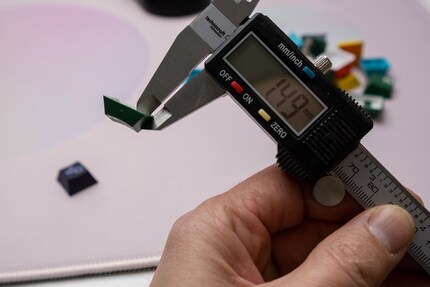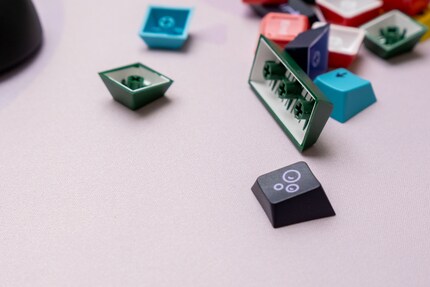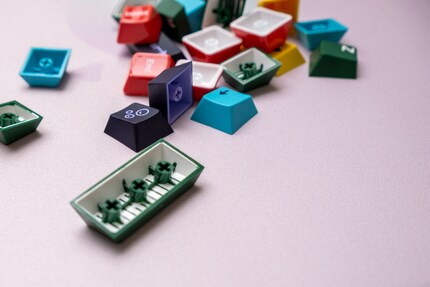
Background information
Chopping boards: wood or plastic, that is the question here
by Martin Rupf

Most keycaps are made of either ABS or PBT plastic. ABS has a worse reputation than PBT. But it all comes down to quality.
Are keycaps made of ABS or PBT plastic better? Here’s the standard rule:
ABS is the cheapest and most commonly used keycap material. PBT is less common, but higher quality. ABS keycaps are smooth and start to shine with finger grease. PBT caps are rougher and therefore more durable.
In principle, these statements are correct. However, this can quickly change depending on the manufacturer.
Acrylonitrile Butadiene Styrene is a copolymer. ABS is durable, long-lasting and inexpensive to produce. So, a keycap made out of the composite won’t break when typing. However, over years of use, the material can suffer, especially if the keycap is thinly moulded. This is often the case with prefabricated keyboards, less so with thicker caps. 1.3 millimetres or thicker is solid enough and won’t quit on you.

ABS usually presents a smooth surface. Consequently, cheap keycaps will develop a greasy/shiny look within a very short time. Higher-quality caps are slightly roughened and feature a protective layer. Nevertheless, they usually become shiny faster than PBT models. On the other hand, ABS presents stronger colours. PBT colours may look washed out in comparison.
Polybutylene Terephthalate is a thermoplastic. When it comes to finished keyboards, this material is usually found in more expensive models. It costs more to produce because it’s more complex. PBT is harder than ABS and therefore even more durable. Caps made of PBT are rougher and less prone to becoming shiny than ABS keycaps. However, keycaps using this material can still develop a greasy/shiny look eventually.
PBT keycaps are usually thicker than those made of ABS. Since they’re also denser, they’re heavier. As a result, they produce a slightly lower-frequency noise when typing.
Here’s an overview of the differences between both materials:
Of course, there are other materials from which keycaps can be made. Recently, ceramic ones have become popular. They’re already shiny from day one, and are even smoother than ABS. Compared to the two plastics, a single keycap weighs more than three times as much. As a result, they produce a deeper sound when typing than plastic. Best you listen for yourself:
Aluminium and resin keycaps are usually sold as individual keycaps rather than complete sets. Light metal caps go even further than ceramic ones, heavier and producing an even lower sound. Synthetic resin caps have similar characteristics to ones made of ABS.
Besides the different materials, keycaps also differ in their lettering. More specifically, by the way indentations are added. On cheapo models, they’re simply glued on. As a result, they wear out very easily and can also come off completely.
Laser engraving is a bit better. Here, fonts are etched with a laser. This also allows for translucent features needed in RGB lighting. Since the ink around the lettering wears off from typing, this method also isn’t optimal.
Thermal sublimation is even better. In this process, inscriptions are vaporised/fused. This should keep them from blurring even with years of daily use.

Double injection moulding is considered the be-all, end-all. Here, imprints aren’t made on a key cap after, but during the casting process. Lettering is included in the cast. This makes it virtually impossible for anything to wear out.

Although PBT is better than ABS according to the above guideline, it isn’t gospel. As is so often the case, it depends on your preferences and whether you purchase a quality product. This starts with feel. If you prefer a smooth rather than a rough surface, ABS is better than PBT. Aesthetics also play a role. If you like bold colours, ABS is also better. Another important feature is sound. Due to its weight and hardness, PBT produces a deeper sound when used than ABS.
Further, the quality of keycaps depends on the type of lettering. You should keep away from stickers. Laser-engraved caps should be the minimum.
All in all, you shouldn’t write off either ABS or PBT from the outset. If you go for high-quality keycaps and consider your choices carefully, you can't go wrong with either material.
From big data to big brother, Cyborgs to Sci-Fi. All aspects of technology and society fascinate me.
Interesting facts about products, behind-the-scenes looks at manufacturers and deep-dives on interesting people.
Show all
Background information
by Martin Rupf

Background information
by Kevin Hofer

Background information
by Stephanie Vinzens